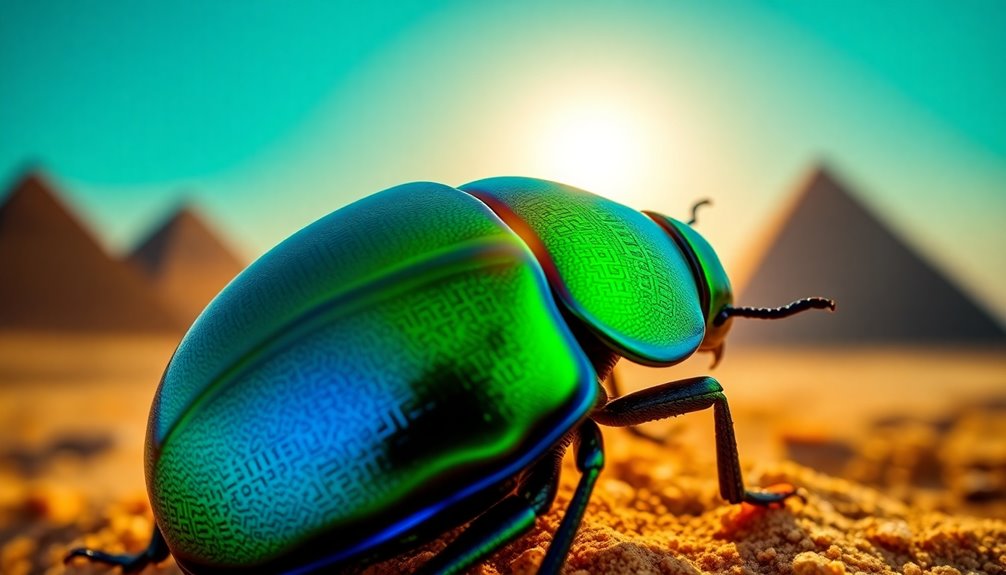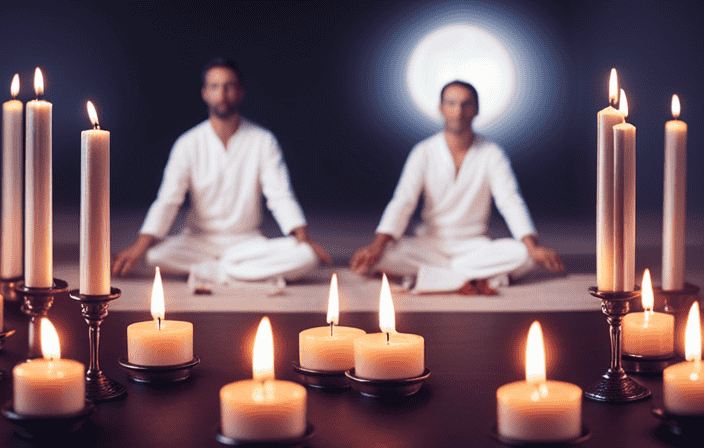Scarabs played a significant role in ancient Egyptian culture, symbolizing resurrection and protection. These beetles, tied to deities like Khepri, embodied the cycle of life and the afterlife. You'd find heart scarabs inscribed with spells to assist the deceased in their journey after death. Over time, scarabs evolved into intricate jewelry, showcasing artistic flair and spiritual significance. Today, they inspire tattoos and collectibles, reflecting their timeless appeal. Their popularity links the past with modern culture. If you're intrigued by this rich history, there's much more to explore about these enchanting symbols of endurance and protection.
Key Takeaways
- Scarabs symbolize eternal life and resurrection, highlighting the ancient Egyptian belief in the cycle of rebirth and renewal.
- Heart scarabs, inscribed with protective spells, were placed in tombs to assist the deceased during the afterlife judgment.
- Scarabs are closely associated with the sun god Khepri, representing the daily cycle of life and the emergence of life from death.
- The artistic evolution of scarabs reflects their growing significance, transitioning from simple seals in the Old Kingdom to ornate amulets in later periods.
- Today, scarabs are popular cultural icons, featured in jewelry and tattoos, symbolizing protection, good luck, and themes of regeneration.
Scarabs and Dung Beetles

The scarab beetle, particularly known as Scarabaeus sacer, plays a fascinating role in ancient Egyptian culture. As you explore the significance of these dung beetles, you'll see how the ancient Egyptians admired their unique behavior of rolling dung into balls. This act symbolizes the cycle of life, resonating deeply with their beliefs.
They associated the scarab with Khepri, the sun god who represented creation and rebirth, reflecting the sun's daily journey across the sky. The dung ball, which beetles bury underground, served as a powerful metaphor for life emerging from the earth. This connection reinforced the relationship between nature and the divine in Egyptian mythology.
Scarabs became prominent symbols in ancient artifacts, often depicted in art, jewelry, and scarab amulets. These amulets held significant religious importance, as they were believed to provide protection and symbolize immortality.
Through their reverence for scarabs, ancient Egyptians expressed their understanding of the eternal cycle of life and death. The scarab's role in their culture illustrates how a simple beetle could embody profound spiritual beliefs, intertwining daily life with the divine.
Symbol of Resurrection
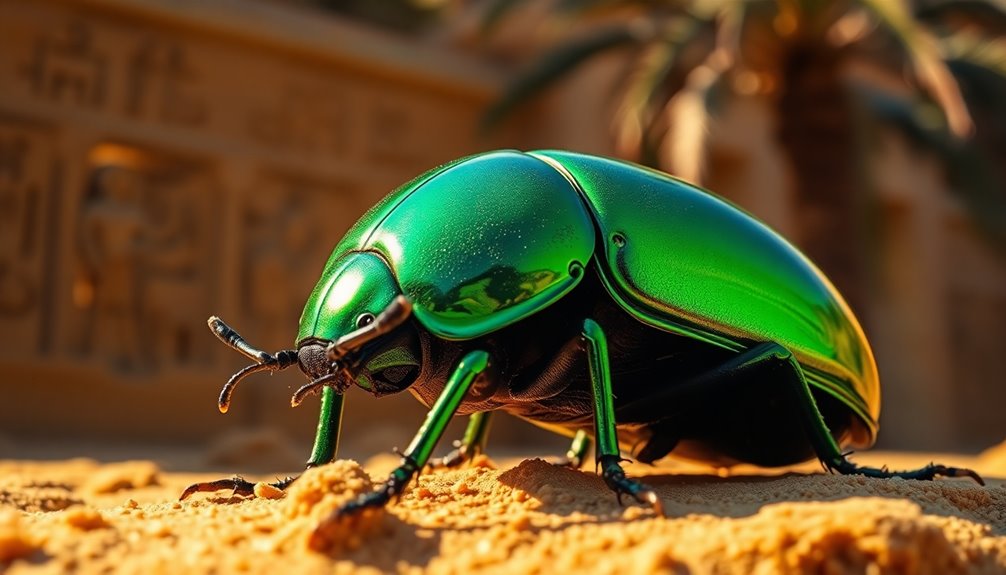
In ancient Egypt, scarabs weren't just insects; they symbolized the profound belief in eternal life.
Their connection to the sun god Khepri reinforced ideas of resurrection and renewal, making them central to funerary practices.
Eternal Life Beliefs
Resurrection symbolizes hope and continuity in ancient Egyptian beliefs, with the scarab beetle standing at the forefront of this ideology. The scarab was more than just an insect; it embodied the concept of eternal life and the cyclical nature of existence.
Associated with the sun god Khepri, who rolled the sun across the sky each day, scarabs represented the daily rebirth of life.
In ancient Egypt, scarabs played a vital role in funerary practices and were often included in burials. They were believed to provide protection and assistance for rebirth in the afterlife.
Here are a few key aspects of scarabs in relation to eternal life:
- Heart Scarabs: Inscribed with spells, these were placed on the chest during mummification to guarantee a successful journey to the afterlife.
- Amulets: Scarab amulets were common, acting as talismans for the deceased to navigate the challenges of the afterlife.
- Cultural Depictions: Scarabs frequently appeared in religious art, reinforcing their significance as symbols of life emerging from death.
Through these beliefs, the scarab became a powerful emblem of resurrection and immortality.
Sun God Connection
A deep connection exists between the scarab beetle and the sun god Khepri, highlighting the powerful symbolism of resurrection in ancient Egyptian culture.
In Ancient Egyptian Mythology, Khepri embodies rebirth and renewal, mirroring the sun's daily rise and setting. The scarab beetle's behavior of rolling dung symbolizes the sun's journey across the sky, reflecting the cyclical nature of life and death.
Ancient Egyptians placed scarabs in tombs, believing they assisted the deceased on their journey to the afterlife. This practice emphasized the idea that scarabs could facilitate resurrection and eternal life, reinforcing the belief that life continuously emerges from death.
The scarab beetle, as a symbol of regeneration, became deeply intertwined with Khepri's essence, embodying the sun god's transformative powers.
As a result of this association, scarabs evolved into powerful amulets, thought to offer protection and promote rebirth in the afterlife.
You can see how the scarab beetle not only represented the natural world but also served as a crucial link to spiritual beliefs about resurrection, reinforcing the enduring legacy of the sun god Khepri in ancient Egyptian society.
Funerary Practices Significance
The significance of funerary practices in ancient Egypt can't be overstated, particularly regarding the symbolism of scarabs. These remarkable beetles were more than just insects; they represented the deceased's journey toward rebirth and resurrection. Scarabs were used in various ways, emphasizing their crucial role in the afterlife beliefs of the ancient Egyptian civilization.
Here are a few key aspects of their symbolism:
- Heart Scarabs: These were inscribed with protective spells and placed on mummies' chests, guaranteeing safe passage through the afterlife judgment.
- Protection against Evil Spirits: Funerary scarabs often featured names and inscriptions, linking the deceased to divine protection in the afterlife.
- Cyclical Nature of Life: The scarab's behavior of rolling dung mirrored the regeneration and eternal life, reinforcing beliefs about life and death's interconnectedness.
The winged scarab symbolized the soul's ascent, closely associated with the sun god Khepri, embodying hope and transformation.
Through these practices, ancient Egyptians sought not just to honor their dead but to guarantee a safe journey into eternity, reflecting their profound beliefs in life after death.
Connection to Egyptian Gods
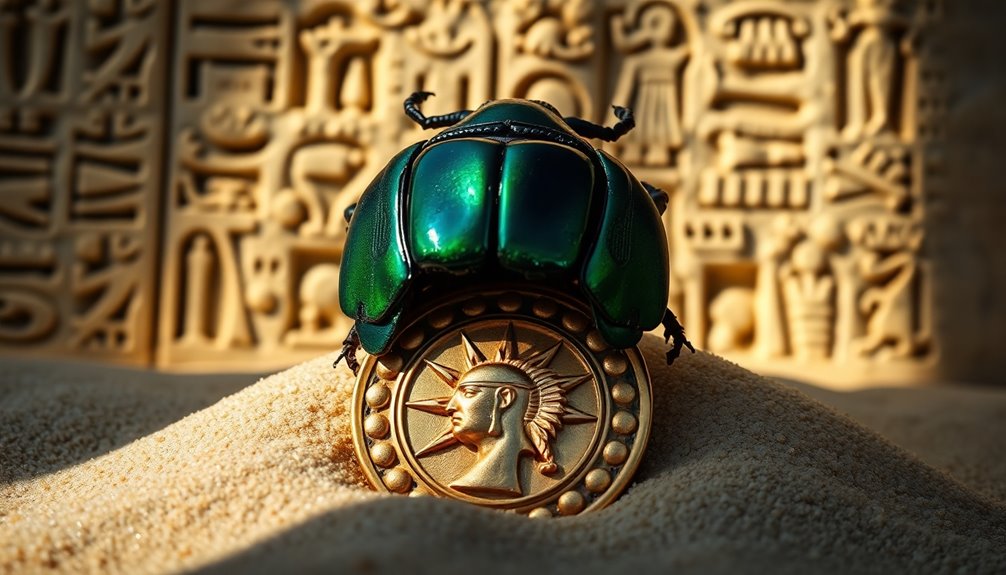
Scarab beetles are more than just fascinating insects; they hold a profound connection to Egyptian gods, particularly Khepri, the sun god symbolizing renewal and rebirth.
In ancient Egyptian mythology, Khepri embodies the daily cycle of the sun, illustrating the themes of perpetual motion and the cyclical nature of life and death. Scarabs weren't just symbolic; they represented Khepri rolling the sun across the sky, reinforcing the notion of transformation and continuity.
Additionally, Atum, the god of primordial creation, and Re, the sun god, were also linked to scarabs, highlighting their role in the creative powers of the sun. In religious art, you'd see scarabs depicted as reincarnations of Khepri, serving as powerful reminders of divine influence on life and the afterlife.
During funerary practices, scarabs were placed in tombs to aid the deceased in their journey to the afterlife, reflecting a deep belief in divine protection and resurrection.
Historical Evolution of Scarabs
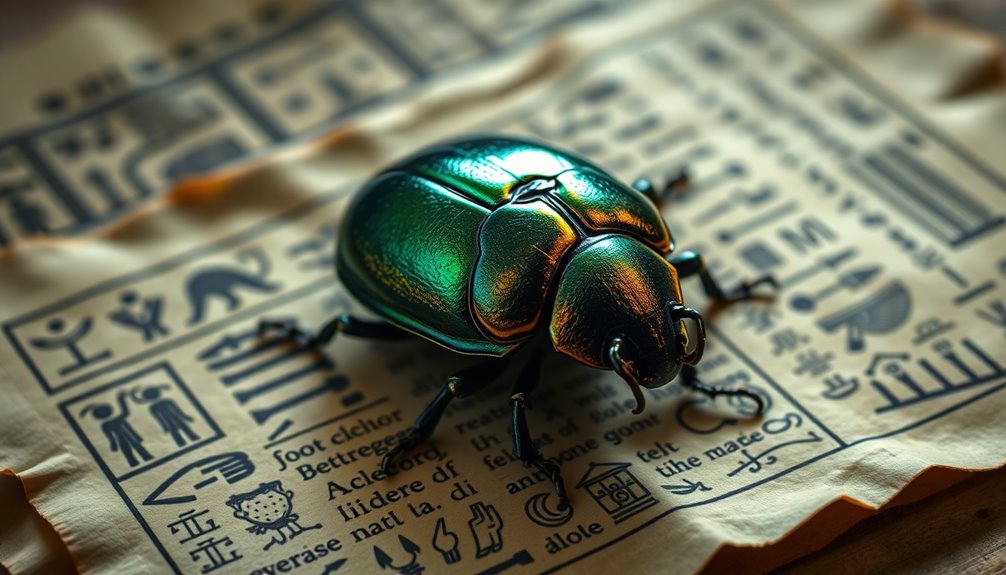
Throughout ancient Egyptian history, scarabs transformed considerably, evolving from simple uninscribed seals in the Old Kingdom to intricate amulets by the New Kingdom.
Initially, during the 6th Dynasty of the Old Kingdom (around 2345-2181 BC), scarabs served as basic stone seals. As time progressed into the Middle Kingdom, their popularity and significance grew, and they began to be used as seals and everyday objects.
By the New Kingdom, scarabs held substantial religious importance, often inscribed with names and spells, reflecting their crucial role in funerary practices. Heart scarabs became a common feature, placed on the chest of mummified remains to assist the deceased in their journey to the afterlife.
Key aspects of this evolution include:
- Shift from seals to decorative amulets
- Use of diverse materials like faience and gemstones
- Inscription of spells to enhance spiritual significance
This remarkable evolution shows how scarabs weren't just ornamental but integral to the beliefs and customs of ancient Egyptians, illustrating their enduring legacy in history.
Scarabs in Jewelry

In ancient Egypt, countless individuals adorned themselves with scarab jewelry, believing it brought protection and good fortune. This trend flourished particularly during the New Kingdom, where scarabs became more than just decorative items; they symbolized spiritual power for the wearer.
Crafted by ancient Egyptian artisans, scarab jewelry showcased intricate designs and vibrant colors, often reflecting the artistic skills of the time. These enthralling pieces took various forms, including necklaces, tiaras, bracelets, and earrings, making them a popular choice for both everyday wear and special occasions.
Scarabs were frequently inscribed with protective spells and hieroglyphs, enhancing their role as amulets believed to ward off misfortune and attract good luck.
As you explore the allure of scarab jewelry, you'll appreciate its rich history, dating back to the Middle Kingdom, when these symbols of protection became integral to ancient Egyptian culture.
The craftsmanship behind each piece not only highlights the skill of the artisans but also reflects the deep-seated beliefs of a society that valued the power of the scarab. Today, these exquisite artifacts remain highly sought after, enthralling collectors and enthusiasts alike.
Funerary Scarab Significance

Funerary scarabs played an essential role in the ancient Egyptians' belief in the afterlife journey.
They symbolized protection and were meant to guide the deceased safely through the underworld.
Role in Afterlife Journey
Scarab amulets played an essential role in the ancient Egyptians' beliefs about the afterlife journey, serving as powerful symbols of protection and rebirth.
These funerary scarabs were placed on the chest of mummified bodies to safeguard the heart, ensuring a safe passage into the afterlife. They symbolized resurrection and regeneration, reflecting the deep connection between life and death.
Funerary scarabs often featured inscriptions with spells and prayers designed to aid the deceased during their journey through the underworld.
Here are some key aspects of their significance:
- Heart Protection: The heart scarab represented the deceased's heart, which was weighed against the feather of Ma'at to determine their fate.
- Khepri Connection: Scarabs were associated with the sun god Khepri, whose daily rebirth mirrored the belief in life after death.
- Immortal Legacy: During the New Kingdom, intricately designed scarabs became common in burial artifacts, emphasizing the quest for immortality.
Through these practices, scarabs embodied the ancient Egyptians' profound understanding of the afterlife's complexities, reinforcing their beliefs in resurrection and the eternal journey of the soul.
Symbol of Protection
Often regarded as a powerful symbol of protection, scarabs held an important place in ancient Egyptian funerary practices. Funerary scarabs were carefully placed on the chests of mummies during mummification, representing the deceased's hope for safe passage to the afterlife.
These scarabs weren't just decorative; they were inscribed with spells and prayers designed to safeguard the departed, ensuring their journey through the underworld was unhindered.
In ancient Egyptian belief, scarabs symbolized the heart, which played a significant role in the soul's fate after death. The heart would be weighed against the feather of Ma'at, the goddess of truth and justice, to determine if the soul was worthy of entering the afterlife.
The use of heart scarabs peaked during the New Kingdom, highlighting their growing significance in funerary customs.
Crafted from materials like faience and stone, funerary scarabs often featured intricate designs that blended artistic beauty with spiritual meaning.
Modern Scarab Popularity
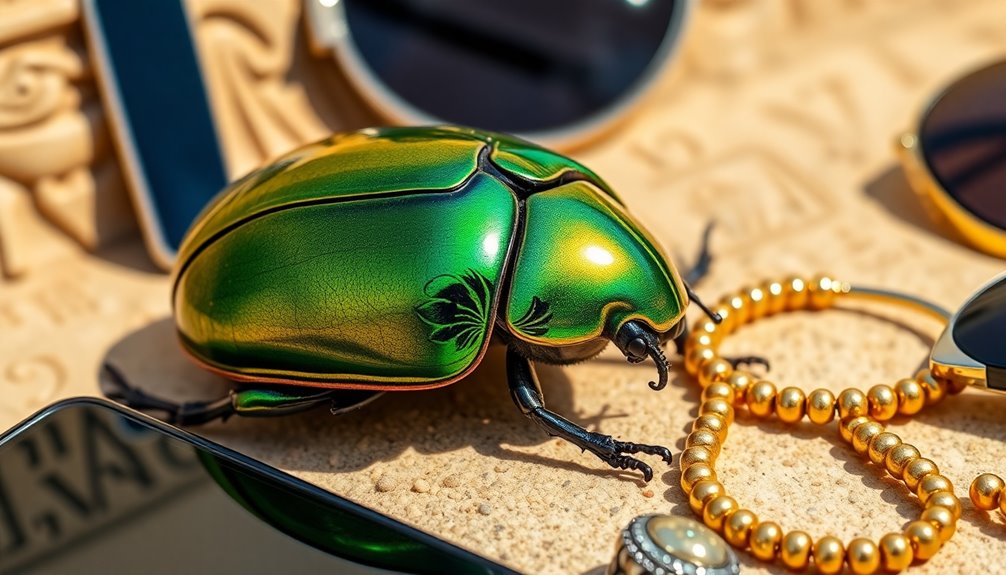
In today's world, the scarab beetle has transformed from a revered symbol of ancient Egypt into a popular cultural icon. You'll find modern scarabs in various forms, from scarab jewelry to tattoos, all celebrating their rich history and symbolism.
Though their religious significance has faded, they still represent protection and good luck for many. You might be surprised by how widespread their appeal has become.
Consider these three popular aspects of modern scarab culture:
- Scarab Jewelry: Intricate designs evoke feelings of antiquity and charm, often worn for their protective qualities.
- Tattoos: Scarab tattoos embody themes of rebirth and regeneration, drawing inspiration from ancient Egyptian beliefs.
- Collectibles: Enthusiasts seek authentic artifacts or high-quality reproductions of ancient Egyptian scarabs, fueling a vibrant market.
Artists today continue to reinterpret these motifs, blending ancient aesthetics with contemporary culture.
Whether you're wearing a piece of scarab jewelry, sporting a tattoo, or collecting artifacts, you're embracing a legacy that links the past with the present.
The scarab's enduring popularity showcases the timeless allure of its symbolism and artistry.
Frequently Asked Questions
What Are Some Facts About Scarabs in Ancient Egypt?
Scarabs in ancient Egypt were much more than just beetles; they held deep symbolic meaning.
You'd find them as amulets, especially the heart scarab placed during mummification to protect the deceased. They represented the sun god Khepri, symbolizing rebirth.
Pharaohs commissioned scarabs to commemorate victories and significant events, serving as historical reminders.
Crafted from materials like faience and gemstones, you'd often wear them as jewelry for protection and good fortune.
How Old Is the Scarab?
The scarab dates back to Egypt's Old Kingdom, around 4,500 years ago.
You'll find that the first scarab amulets emerged during the 6th Dynasty, around 2323-2150 BC.
Initially, they were simple uninscribed stone seals, but as time went on, their designs evolved remarkably.
What Is the Power of Scarab?
Have you ever wondered why the scarab beetle holds such power?
In ancient cultures, scarabs symbolized regeneration and protection. You'll find that they were believed to ward off evil spirits and guarantee a favorable afterlife journey.
Worn as amulets, these beetles were thought to bring good fortune. Their association with the sun god Khepri emphasized the idea of rebirth, making them a potent symbol of life emerging from death.
Do Egyptian Scarabs Still Exist?
Yes, Egyptian scarabs still exist today! You can find them in various regions of Egypt, especially in deserts and agricultural areas.
These beetles, particularly the Scarabaeus sacer, play an essential role in the ecosystem by breaking down dung and waste, which enriches the soil.
While their religious significance has faded, scarabs remain a cultural symbol of regeneration and protection, enchanting tourists who often buy scarab replicas and jewelry as souvenirs.
Conclusion
So, the next time you see a scarab, remember it's not just a quirky little beetle. It's a symbol of resurrection, a connection to ancient gods, and a piece of history that's endured through the ages. Ironically, while we often view these insects as pests, they were once revered in a culture that saw them as divine protectors. Who knew something so small could hold such monumental significance? You might just find yourself appreciating the humble scarab in a whole new light.
